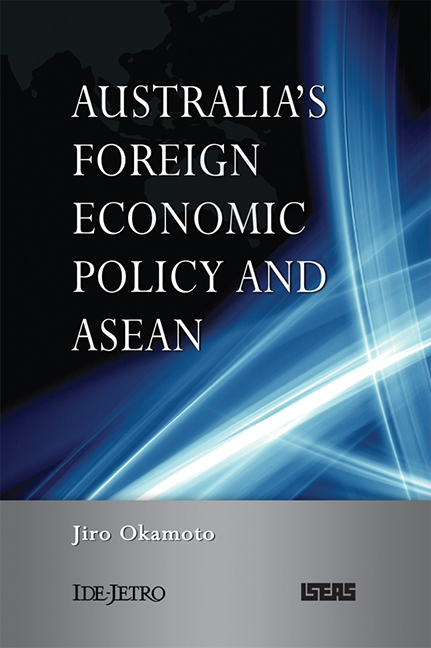Book contents
- Frontmatter
- Contents
- List of Figures and Tables
- Abbreviations and Acronyms
- Acknowledgements
- 1 Introduction
- 2 An Analytical Framework
- 3 State-Society Coalitions and Australia's Foreign Economic Policy
- 4 Australia and the Formation of ASEAN
- 5 The Trade Liberalizers and Asia-Pacific Regionalist Strategies
- 6 The Development of ASEAN Regionalism and the AFTA–CER Linkage Dialogue
- 7 The Bilateralists and their ASEAN Policy
- 8 Conclusion
- Appendix: Foreign Economic Policy-Related Ministers in Australia since 1941
- References
- Index
- About the Author
5 - The Trade Liberalizers and Asia-Pacific Regionalist Strategies
Published online by Cambridge University Press: 21 October 2015
- Frontmatter
- Contents
- List of Figures and Tables
- Abbreviations and Acronyms
- Acknowledgements
- 1 Introduction
- 2 An Analytical Framework
- 3 State-Society Coalitions and Australia's Foreign Economic Policy
- 4 Australia and the Formation of ASEAN
- 5 The Trade Liberalizers and Asia-Pacific Regionalist Strategies
- 6 The Development of ASEAN Regionalism and the AFTA–CER Linkage Dialogue
- 7 The Bilateralists and their ASEAN Policy
- 8 Conclusion
- Appendix: Foreign Economic Policy-Related Ministers in Australia since 1941
- References
- Index
- About the Author
Summary
From the early 1970s, the international environment continued to be unfavourable for the Australian economy. The demand for Australia's traditional exports did not improve. Changes in the international economic structure were clearly reflected in the rapid development of East Asian economies, especially the Asian NIEs and ASEAN members, as they adopted outward-looking, trade-oriented development strategies. The beginning of “globalization” of national economies, which was characterized by active movement of goods, services, capital and information across borders, was a main cause of this development.
The contrast was stark between Australia's economic conditions and those of the East Asian economies and this had a heavy impact on Australia's foreign economic policy thinking. Some government Departments and parts of the business community argued that Australia should aim at taking full advantage of the dynamic development of East Asian economies by enmeshing the Australian economy with those in East Asia. They argued that, in order to enable the building of closer economic relations with East Asian countries where the economic structure was rapidly changing, Australia needed to have variety in its competitive export items and not just export traditional primary commodities. In this context, too, reform of the domestic industrial structure was required.
After another massive decline in the terms of trade in the early 1980s, pressure from anti-protectionist forces both within and outside the government grew even stronger. The Fraser Government implemented some liberalization measures but in principle held on to protectionist policies. The comprehensive reorientation of Australia's foreign economic policy had to wait until after the Hawke Government came into office in 1983.
This chapter explains how the replacement of the dominant coalition, the protectionists by the trade liberalizers, in the mid-1980s affected Australia's policy towards ASEAN. First, the chapter reviews the development of trade relations between Australia and East Asian countries starting in the 1960s and examines how interdependence deepened over the period. Second, it is explained that, to underpin its MFN-based liberalization and deregulation efforts for the reform of the domestic economy, the Hawke Government also sought multilateral trade and investment liberalization. In doing so, the government deployed “Asia- Pacific regionalist” strategies which aimed at using regional cooperation as a springboard, or a catalyst, for multilateral trade and investment liberalization. Third, focusing on ASEAN policies and relations with ASEAN in the context of Australia's multilateral economic diplomacy, the Cairns Group and APEC initiatives are examined.
- Type
- Chapter
- Information
- Australia's Foreign Economic Policy and ASEAN , pp. 132 - 162Publisher: ISEAS–Yusof Ishak InstitutePrint publication year: 2010

